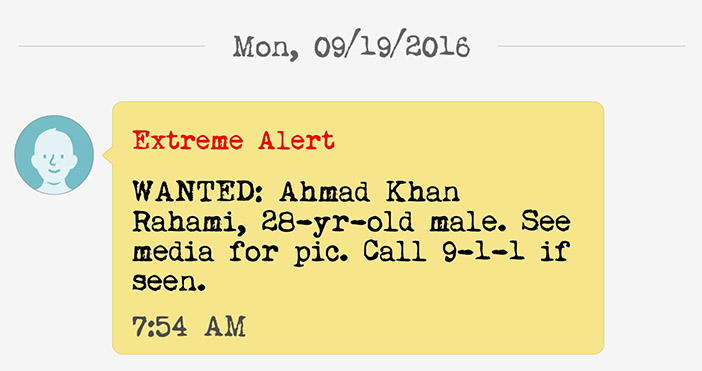Courtesy of Michael V. Cusenza
Actual message sent to Forum Editor Michael Cusenza’s cell phone hours after the bombing.
By Forum Staff
Last week’s terror threat in New York/New Jersey highlighted a major weakness in our Wireless Emergency Alert System (WEA). Millions of New Yorkers received notifications from the system when suspected terrorist Ahmad Khan Rahami was on the run and authorities called on the public to help locate him––the only problem was that the notifications contained only text because the system is incapable of delivering multimedia links, images and has a limit of 90 characters. Instead anyone who wante to actually see Rahami’s picture was forced to search for it through Google or other search engines. Now, Sen. Charles Schumer (D- New York) is calling on the FCC for immediate modifications to the system.
“In light of the need to respond in real time to terror threats, we can’t afford to have an emergency wireless response system that is stuck in the 90’s. The bottom line is that in the era of Instagram, Facebook and SnapChat our Wireless Emergency Alert System needs to get as smart as our phones and be updated so it can deliver photos and other media that has information that can save lives,” said Senator Schumer. “When it comes to a terrorist or other very dangerous criminal on the run, a picture not only is worth a thousand words, it could save a thousand lives if the right person sees it.”
. The FCC has already proposed updating the WEA system by increasing the maximum length of messages from 90 to 360 characters. Schumer wants the proposals finalized and to make sure that the final product includes multimedia, including picture images and/or videos.
The Wireless Emergency Alert System (WEA) was established through the FCC under the WARN Act. WEA is a public safety notification system which delivers geographically-targeted message alerts reporting imminent threats to safety or life. There are three types of alerts: 1) alerts issued by the President; 2) alerts involving imminent threats to safety or life (i.e.: evacuation orders, shelter-in-place orders, a terrorist threat); and 3) Amber Alerts for abducted children.
There have been several instances in which law enforcement agencies have used WEAs to alert citizens in the wake of a terror threat. In 2013, WEAs were sent to Boston residents warning them to ‘shelter in place’ while the bombing suspects were still at-large. In August, the system was used in Los Angeles to warn residents about a potential active shooter in LAX. And last week, the alert system was sent regarding the Chelsea explosion. That evening, the emergency alert read: “Suspicious package: residents on W 27th b/t 6th and 7th Ave stay away from windows.” After the weekend, another WEA was sent to millions of cell phone users in New York City to be on the lookout for the suspect. Schumer noted that this was the first time such an alert had been issued to track the whereabouts of a suspected terrorist.
New York City has always been on the cutting edge of using emergency public safety technology. And in 2012, New York City became the first local or state alerting authority in the country to issue a WEA message when ordering the mandatory evacuation of its coastal counties during Hurricane Sandy.
On the morning of September 19th, the New York City Police Department (NYPD) requested that the Office of Emergency Management (OEM) send a WEA to every phone in all five boroughs. The OEM’s alert read: “WANTED: Ahmad Khan Rahami, 28-yr-old male. See media for pic. Call 9-1-1 if seen.”
Noting that WEAs are essential and critical in the effort to keep America safe, Scumer maintained that cell phone users must receive the most comprehensive information available when their safety is potentially at risk.

